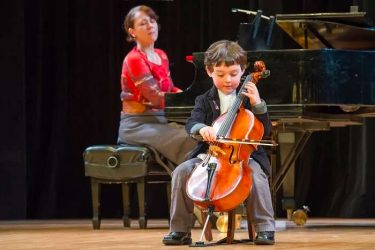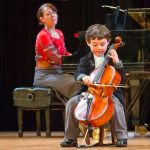
My father emphatically states that when I was an infant-toddler my favorite place was in the arms of my great-grandmother. My great-grandmother died around the time I was three years old. One of my earliest memories is being in her arms as she hummed gospel spirituals, sounds from the hot cotton fields of South Carolina. These songs of old have DNA embedded in them.
Why is music so important to infant-toddlers?
- The fetus is first responsive to sound (narrow band of frequencies 300Hz) around 20 to 25 weeks gestational age.
- Around 33 weeks, the fetus shows relatively consistent heart rate and movement changes in response to music.
- Memory for auditory sequences, the ability to understand the order of sounds, develops early.
- Newborns are able to detect the beat in drum patterns while asleep.
In other words, my great-grandmother knew what she was doing! As a speech and language pathologist who has been working with the infant-toddler and preschool populations in North Carolina for over a decade, I always emphasize music in therapy as a natural way to increase listening skills. Music matters!
I had the pleasure of attending a seminar for special educators at Duke University back in April of 2019 that was led by Joni Alberg, PhD. She is the Cochlear Implant Program Consultant for the Division of Head and Neck Surgery & Communication Sciences at Duke University Medical Center. Joni brought a guest lecturer from “across the pond” by the name of Christine Rocca. Christine Rocca is a musical therapist out of England who provided concrete ways that music can support infant and toddler development. She also provided examples of musical activities that support parents in interacting with their young child.
Music is so important to the growth and development of the young child.
- “Music helps lengthen attention span. Music develops listening and spoken language skills. Music helps with speech and such cognitive skills as memory.” (Patel 2003; Wang, Trehub, Volkova & van Lieshout 2013)
I always make a point to incorporate music when working with infant-toddlers. Here are some musical concepts and activities that I use during therapy that were taught to me by Christine Rocca and that you can try at home.
Musical Activities for Parents and Young Children
- Action Songs: Use songs to find the beat. Clapping to the beat significantly impacts language acquisition. If children aren’t able to clap, try using your hands to clap with them. You can also move another part of the body to the beat. Doing so helps develop motor skills and sustained attention.
- Metal spoons, pots and pans: Break out your pots and pans, along with some metal spoons. Sing “Row, Row, Row Your Boat” while you and your child use the spoons and pots to keep the beat. You should have a spoon and pot, and your child should have a spoon and pot. The high frequency sound of the spoon hitting the pot is helpful when your child hears high frequency sounds such as /s/ and /z/ during speech. Can you think of another nursery rhyme? Although singing without music is preferred, you may use music from your computer or phone if desired. However, it is important that your child hears your voice above all else to encourage listening.
- Keeping the beat/Alternating the beat: Pat your hands on your lap, clap your hands or use the pots and spoons for this activity. For example, you can sing the “ABC” song and keep the beat. Now try alternating the beat with your child while singing the “ABC” song. In other words, it’s a turn-taking activity that requires you and your child to go back and forth through using beats. This is a fun way to challenge listening skills such as auditory closure.
- Slow vs. Fast, Part 1: This is by far my personal favorite. Play “Twinkle, Twinkle Little Star” or any slow song you like. You and your child should slowly rock your hands back and forth as if you were at a rock concert while you sing the song along with the music. Don’t worry, we’re not looking for Mariah Carey! When the song is over, ask your child, “Was it fast or slow?” Pause. Now say, “SLOW!” Next, play Ella Fitzgerald’s “Old MacDonald” on The Ed Sullivan Show, or pick another fast song. See if you and your child can sing along to this one! Shake your hands wildly as the fast music plays. When the song is over, ask your child, “Was it fast or slow?” Pause. Now say, “FAST!”
- Slow vs Fast, Part 2: Now that you have played the fast versus slow songs, introduce pictures of a sleeping baby and food. Show your child the baby versus the food picture as the slow song plays. Ask your child, “Which one?” Slowly guide your child to the picture of the baby. Congratulate your precious child for pointing to the baby. Say, “You pointed to the baby!” Now play the fast song. Show your child pictures of a dancing couple versus a family that is reading. Ask your child, “Which one?” Slowly guide your child to the picture of the dancing couple. Congratulate your precious child for pointing to the dancing couple. Say, “You pointed to dancing!”
Read Next | Kids’ Songs: Playlist Picks
I hope everyone has fun trying these activities with your child. “If immersed in a consistent musical experience developing babies’ brains are able to absorb a comprehensive world of development of their sound, supporting the communication and cognitive abilities.” (Patel 2003)

Read Next | Interview with Deborah Bradley-Kramer, Head of School at MUSE Academy
Kenyatt M. Godbolt, M.S. CCC-SLP is a speech-language pathologist who owns a private practice near Charlotte, NC called Godbolt Consultants, PLLC. He is also an aspiring playwright and author. [email protected]
Like what you read? JOIN the Mommybites community to get the latest on FREE online classes, parenting advice, events, childcare listings, casting calls & raffles, and our Parents With Nannies Facebook group. SIGN UP NOW!



